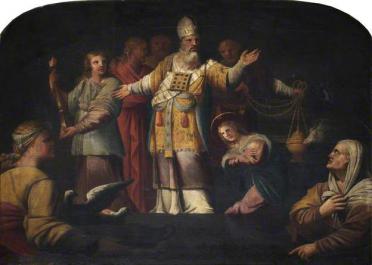Every week, parshaoftheweek.com brings you a rich selection of material on parshat hashavua, the weekly portion traditionally read in synagogues all over the world. Using both classic and contemporary material, we take a look at these portions in a fresh way, relating them to both ancient Jewish concerns as well as cutting-edge modern issues and topics. We also bring you material on the Jewish holidays, as well as insights into life cycle rituals and events...
In Parshat Tetzave we continue to receive instructions about the Tabernacle in the desert. One of them is for Moshe to “Make holy garments for Aharon your brother, for honor and glory.” The notion that the high priests and the other, regular priests, should have some sort of special uniform seems sensible, as does the demand that they be “for honor and glory”, that they should be special, appropriate for the place and occasion.
Nachmanides (the Ramban, Rabbi Moshe ben Nachman, 1194-1270, Spain and Israel), goes to some length to explain what is meant by “honor and glory”. In doing so, he consistently references the clothing “worn by kings in the time of the Torah”, “like the sons of ancient kings”; “known even today as fit for kings and great ministers”. In describing one type of material used in making these garments, תכלת, a purple cloth, he says that “even today, no one would dare wear it other than gentile kings.”
Two interesting themes emerge. One is that, in determining what is, ultimately, a Jewish esthetic – the clothing to be worn by the priests in the Temple – the Torah depends completely on a universal, non-Jewish, esthetic. The high priest is meant to look exactly like a non-Jewish aristocrat. Since this is meant to communicate “honor and glory”, this is not a merely esthetic statement; it is ultimately about values, about what Jews should think “honor” and “glory” look like, and how they should be expressed. And, remarkably, it is a non-Jewish esthetic we reference in order to make that statement about Jewish understandings of importance, beauty, and honor!
This is an extremely powerful statement. Our esthetic values and, along with them, our ethical values, are not meant to exist in a Jewish bubble. We can, and should, look to the world for help in determining how we express important concepts, concepts such as importance, or sanctity, or sacredness. Looking to the non-Jewish world for fashion tips for the high priest points to a willingness to operate in dialogue with that world when making decisions about the way we talk and think about important concepts, how we perform our values, how we express them publicly. We are meant to be in a kind of dialogue with the wider world about these things, and not close ourselves off in some imagined all-Jewish universe. I believe this is true beyond the realm of esthetics, and carries into the connected realm of values, and ethics, which, after all, esthetics are an expression of and companion to.
The second issue is that of the transient (or not) nature of style, fashion, and what they represent and signal. A few times in his explanation, the Ramban uses phrases like “in the time of the Torah”, “the custom is”, “even today…”, which all indicate that there may well be a sell-by date to all of these garments and what they communicate. Telling us that once, years ago, kings and princes dressed in a certain way, and thereby communicated certain things, might indicate that these styles are subject to change, and that a time may come when they express something different – old-fashioned-ness, perhaps, or a primitive world view, or just plain silliness. Virginia Woolf, in her book, Three Guineas, includes photographs of a number of distinguished gentlemen - officers, aristocrats, officials - all looking ridiculous in full regalia – ostrich feathers, leopard skin capes, epaulets, and remarkably shaped hats. When the photos were taken, these gentlemen, and their fans, must have thought they looked extremely impressive, the very epitome of honor and glory. To (some) modern sensibilities, they look ridiculous, barbaric.
Once the Torah mandates ancient royal attire for the high priest, are we meant to never evolve away from the esthetic framework in which they made sense? Are we commanded to think that this stuff will look glorious forever? Is there room for a changing esthetic, and, along with it, a changing understanding of what honor and glory mean, and how they might best be expressed?
To me, after living in Israel for over 45 years, business suits on Shabbat in shul look and feel somewhat inappropriate, out of place, while a white shirt and dark trousers is what indicates “it’s Shabbat” to me; a suit, especially if I am choking on a tie, feels like I’m on a business trip to America. Younger people in Israel dispense with the white shirt altogether, and go with colors. That says a ton about Israel’s more rooted, informal, egalitarian ethos and communal style, and the Jewish American acceptance of contemporary non-Jewish notions of what “dressed up” looks like. Until the post- Six Day War period, when large numbers of American Jews started visiting Israel, it was unheard of to walk into a shul in the US on Shabbat not wearing a suit or sport jacket.
All these sartorial decisions are legitimate. I would hope that the ability to allow “dressing for shabbos” to change and evolve, in time and place, can teach us to be open to evolving understandings of the messages and values expressed by how we dress as Jews.
Shabbat Shalom,
Shimon



Get inspired by Tetzaveh Divrei Torah from previous years